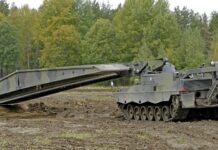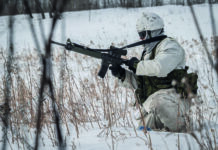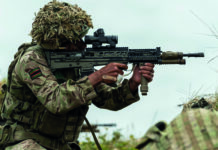Armoured Vehicle Launched Bridge (AVLB) systems enable combat engineers to overcome a variety of gap-crossing challenges to help maintain the momentum of friendly forces on the battlefield.
Keeping the way clear and unimpeded, so friendly troops can keep moving and maintain mobility on the battlefield, is a primary role of combat engineers. Clearing minefields and overcoming obstacles, for which a variety of specialised engineer equipment is available, are just two typical activities on an engineering unit’s very long task sheet. Gap crossing is another and no matter how wide, from the widest river to the narrowest ravine, having the right equipment at their disposal to bridge a gap helps the combat engineer get the job done.
Mobility and counter-mobility is what combat engineering is all about and the equipment employed by these specialist troops can alter the course of a battle by keeping friendly forces on the move, while at the same time denying ease of movement to the enemy.
While spanning the widest rivers requires floating bridge systems like the M3, its smaller gaps and some of the AVLB systems in use and evolving in Europe is the basis which this article is chiefly focused.
Gaps – No Match for European AVLBs
Gaps on the battlefield come in all shapes and sizes. Some are dry, some are wet, some are marked on the map, while others can appear unexpectedly out of nowhere, missed by the cartographers, or, perhaps, having appeared as a result of battle damage. Dealing with the multitude of smaller to moderate gaps anywhere from a few metres up to 60m (by deploying multiple bridge spans) or so in width, is largely the preserve of AVLB-type systems and having a choice of such bridging systems makes for more efficient and effective bridging operations. AVLBs enable vehicles of almost every kind to cross such obstacles, although it is the rapid advance of main battle tanks (MBTs), armoured fighting vehicles (AFVs) and infantry fighting vehicles (IFVs), that is key and for which unimpeded mobility is essential. AVLBs help ensure battlefield momentum is maintained and the fight taken to the enemy.
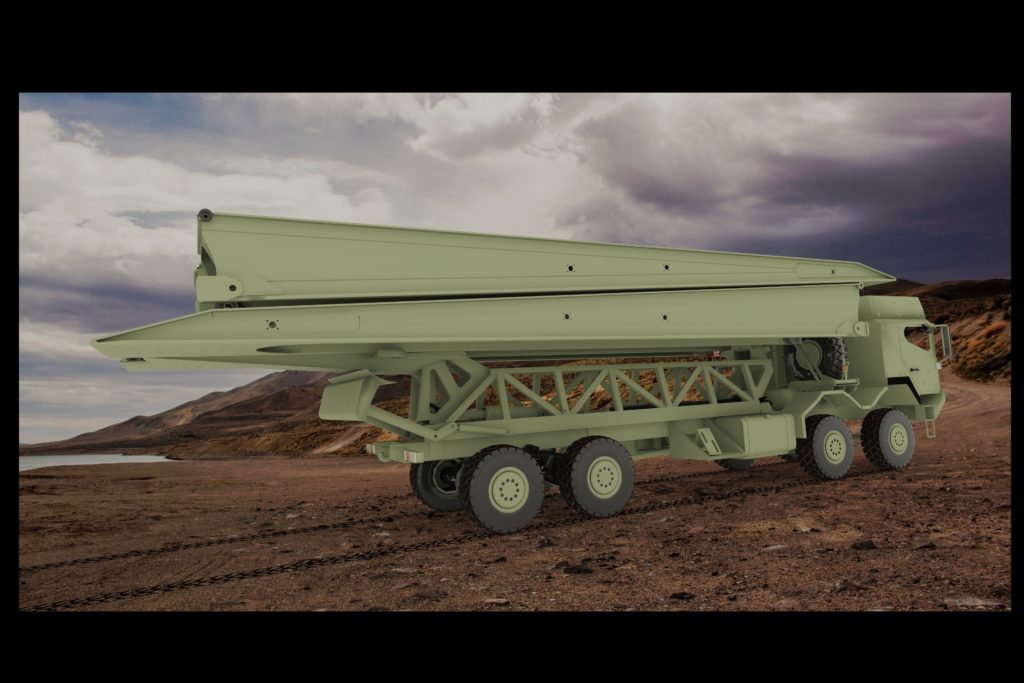
A typical AVLB enables AFVs and IFVs to cross anti-tank ditches, blown bridges, craters, railroad cuts, canals, rivers and ravines, usually by unfolding its ready-made-bridge payload to span the obstacle in only a matter of minutes, typically without additional support equipment. The vehicle then detaches from the bridge once its in place and moves out of the way to allow the bridge to be crossed. After the last vehicle has passed, the AVLB launch vehicle crosses over itself, re-attaches to the bridge on the opposite side of the obstacle and retrieves the span before moving onwards.
Yet, while AVLBs continue to operate in the same scenarios as they always have, leading industry experts consider the AVLB market is no longer as easily categorised in terms of the traditional medium and heavy system nomenclature as it once was. More often nowadays, individual countries set their own categories. Some may categorise their assets in terms of the bridge length carried by the AVLB, such as 26m, 22m and so on. And while ‘armoured’ is indicative of the bridge being carried atop a tracked or wheeled AFV/IFV type chassis, a wider variety of wheeled systems are entering the space (though will not be considered in great detail in this article) with some up-armouring prior to operational deployments.
AVLBs – An Evolving Mix
Previous tracked AVLBs traditionally comprised converted tank chassis such as the UK Army’s CHIEFTAIN AVLB of the 1970s, and were categorised largely as heavy AVLBs. That ‘beast’ , effectively a CHIEFTAIN MBT chassis less its turret, was fitted with a hydraulic system for laying and recovering either a No.8 or a No.9 Tank Bridge. With an overall length of 24.384 m, the No. 8 bridge could span a gap of up to 23 m from one hard bank to another, or 22 m if both banks were soft. The bridge was carried folded and launched over the front of the vehicle, whereas the shorter, 13.5 m, No. 9 Tank Bridge was carried horizontally as a complete structure and swung vertically through 180° to be laid in position over the front of the vehicle.
UK Evolution
The CHIEFTAIN was replaced in the UK Army by the currently-in-service, TITAN, an armoured engineer vehicle designed to enable troops and vehicles to cross gaps of up to 60 metres by laying a selection of Close Support Bridges (CSBs). Based on the CHALLENGER 2 MBT chassis and with a maximum speed of 59kph delivered by a Perkins CV12 diesel, the system can carry and lay the Royal Engineer’s current range of in-service BR90 close support bridges from BAe Systems, which are built from interchangeable modular components. Though originally designed for Military Load Classification (MLC) 70 tracked vehicles and supplied by BAe Systems over more than 30 years, the bridges can be crossed under controlled safety conditions by vehicles of up MLC 85, which allows for the increase in load posed by the latest CHALLENGER 2 variants. However, the future of BR-90 bridging is being addressed under the UK MoD’s Project TYRO with a variety of industry players currently vying for participation. Amongst other things, the project requirement is for a CSB ‘set’ that can be launched and recovered rapidly by TITAN and that has a load classification of at least MLC100 for tracked vehicles.
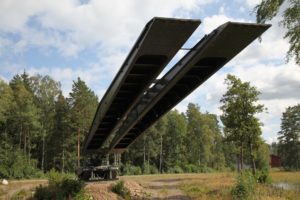
The BAE Systems’ approach to replacing the BR90 system has been to ‘evolve’ its BR90 bridges for the project/tender into a new Modular Bridging System (MBS), which includes CSBs for narrower gaps. (Longer modules form part of BAe Systems’ new bridge set, its General Support Bridging – GSB – though are not for deployment by the Titan AVLB). Its CSBs are its new variant No.10 (26m scissor bridge), No.11 (16m single span) and No.12 (13.5m single span) CSBs, which can be launched by Titan in less than two minutes day or night to provide a gap-crossing capability up to 24.5 m, 14.5 m, and 12 m, respectively. TITAN can also carry two No.12 bridges at the same time. Launch can take place without leaving the launch vehicle to maintain crew protection, and the upgraded bridging will meet the heavier payload requirement of the tender, thus enabling the unrestricted use of the bridging by all UK Army vehicles, including CHALLENGER 2 and its variants. BAe Systems’ MBS, as per Project TYRO’s stipulations, will meet UK Army needs to 2040 and beyond.
Co-operating with BAe Systems on Project TYRO is General Dynamics European Land Systems (GDELS). If BAe Systems win any one part of the tender, CSB or GSB, GDELS will manufacture the bridges. The partnership between the two companies was announced at DSEI in 2017 when it was stated that, if successful, the new MBS bridge panels would be made by GDELS before being shipped to BAe Systems for assembly and testing.
Concerning ReBR90 bridging, its worth noting that the bridging can also be launched by the engineers’ ABLE (Automated Bridge Launching Equipment) 8×8 truck, which was deployed to Afghanistan with a heavily armoured cab.
In Widespread Use
Krauss-Maffei-Wegmann’s LEGUAN AVLB was conceived initially for use on the LEOPARD 1 MBT chassis, a version which entered service with several military customers. Now offered on the LEOPARD 2 chassis with performance capabilities commensurate with the MBT, the AVLB can carry and deploy a single 26 m bridge, or two 14 m bridges with a load classification of MLC80. In controlled and also exceptional circumstances, load classification up to MLC110 can cross. LEGUAN’s fully automatic launching system enables bridges to be laid in approximately five minutes. Its horizontal launching technique maintains a low silhouette, which offers a moderate tactical advantage over those systems, which deploy bridges vertically. The whole operation is automated and performed by the driver via a system menu, but can also be performed independently by the commander. In its LEOPARD 1 configuration LEGUAN has been in operation with Belgian, Chilean, Finnish, Greek, Norwegian and Turkish Armed Forces.
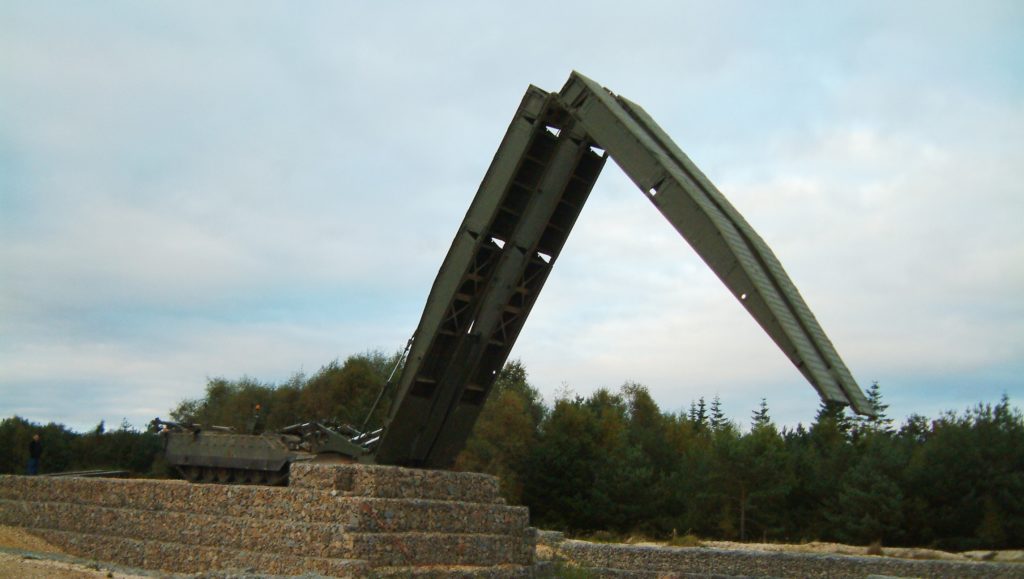
In June last year, the Finnish Defence Forces (FDF) announced the modernisation and expansion of its LEGUAN AVLB fleet with the signing of a contract between KMW and the FDF’s national general contractor for the project, Patria Land Systems. This has enabled the FDF to lay short LEGUAN bridges, as well as modernising all systems to enhance performance and the future, overall viability of the system. In addition to the upgrades of its existing fleet, four new LEOPARD 2L LEGUAN systems were ordered and will carry both the 26 m and the two shorter bridge spans. The timeframe for contract activities and deliveries is from 2019 to 2021.
In March this year, Norway, which has been using the LEGUAN on the LEOPARD 1 chassis for over two decades, signed an agreement with KMW for the procurement of six LEOPARD 2-based LEGUAN AVLBs along with training simulators and a peripheral package. The delivery of these latest AVLBs will start in the summer of 2022. This makes Norway the eighth LEGUAN-using country moving from LEOPARD 1 to the next generation of the system on LEOPARD 2. At this time, armies from 18 countries are using the LEGUAN AVLB. According to a spokesman for KMW talking with ESD, the LEGUAN story began “in the mid-1980s, with Norway as one of KMW’s launch customers. The fact that today the Flagship LEGUAN Leopard 2 is already in use, or has been ordered by eight nations, including Germany, underpins a level of AVLB interoperability that can be expected between these predominantly NATO nations when operational in theatre”.
While LEOPARD 1 and 2 are its typical carriage vehicle chassis, the modularity of the system has enabled it to be fitted onto other MBT chassis, including in Poland on the T91, and in Spain aboard the M60/M47 MBT chassis. The US has also used it aboard the M60 and M47, but it is now chiefly carried on the M1A1/A2 as the WOLVERINE Heavy Assault Bridge. In Malaysia, it sits aboard the T-72 and PT91 chassis, and in South Africa on the OLIFANT.
LEGUAN evolved from the BIBER bridge AVLB on LEOPARD 1 and in service with the Bundeswehr from the 1970s until the LEOPARD 2 version was adopted by them in 2009.
KMW told ESD that while the regular load of today’s 26 m and 14 m bridges is MLC80, there is growth potential to offer a standard MLC100 capability and that the design of the bridges not only meets TDTC (Trilateral Design and Test Code for military bridging and gap-crossing equipment) specs, but also more demanding requirements. The TDTC is used to confirm that equipment will meet the performance specified by the user, although the code requirements are seen as the minimum acceptable performance standards. Hence, KMW stresses that the bridges go beyond these needs. For example, the bridges are equipped with load-cycle monitors for improved safety and the LEOPARD launch vehicle has an all-around vision system for day and night operations. The 14 m bridge can also be handled by medium-sized tracked AFV platforms like the CV90, as well as wheeled systems like BOXER. This compatibility with other widely used vehicles adds further to its interoperability in terms of spares and logistics on the battlefield. LEGUAN has also been integrated on the MAN 8×8 and the Finnish SISU 10×10 wheeled chassis.
KMW has stated that the ‘battle-proven’ LEGUAN is the ‘most modern and most widespread assault bridge system’ and indicated that they consider it already having become ‘the assault bridge standard in modern armies’. The company expects more countries will consider LEGUAN in the coming years carried either on tracked and/or wheeled chassis.
The UK company WFEL is collaborating with KMW, its parent company, in the UK Project Tyro process, under which WFEL would manufacture the LEGUAN bridge to meet the CSB part of the tender if KMW is successful.
Most Comprehensive Portfolio
Another major player in the AVLB marketplace is General Dynamics European Land Systems Bridge Systems, part of GDELS, as mentioned above in relation to its co-operation with BAe Systems on the UK Ministry of Defence’sProject TYRO.
GDELS has probably the largest portfolio of bridging systems in the defence marketplace, covering pretty much all categories of bridge from ultra-lightweight systems all the way up to major floating bridge and ferrying systems like the M3. In between, it addresses the ALVB market with its latest COBRA, PYTHON and ANACONDA solutions.
COBRA, a brand new innovation, is what GDELS calls its Variable Folding Bridge. It is a medium AVLB designed to handle medium-weight wheeled and tracked armour traffic across a range of weight classifications.
The bridge has unprecedented flexibility due to its ‘special design’, which allows it to be of various lengths depending on customer needs, as well as whichever designated armoured tracked or wheeled carrier vehicle has been chosen to carry it. In its lower length variation of 15 m, its MLC classification can support the heaviest MBTs up to and beyond MLC 100, whereas its longer version supports lower weight MLC classes down to MLC 40. Deployment of the bridge, which can be conducted by the crew in fully closed down conditions under armour, takes around two minutes. COBRA’s Bridge Launch Mechanism (BLM) from Pearson Engineering, is easily adapted for integration on a variety of multi-purpose vehicle platforms. Its modular approach enables carrier vehicles to be equipped with the bridge on either temporary, using a further piece of kit from Pearson Engineering – the Jettison Fitting Kit – as well as on a permanent basis. This USP allows the armoured platform to be freed up and used for other roles on the battlefield, as necessary.
COBRA’s ‘special design’, with the bulk of the bridge weight towards the rear, moves the centre of gravity of the whole platform towards the back of the vehicle. This allows the carrier platform to deploy a wider range of bridging in terms of weight-carrying capability, as well as length, compared with similar medium AVLB systems. Moving the centre of gravity to the rear also gives COBRA greater mobility on the battlefield. If the bridging centre of gravity is towards the front of the vehicle, this increased weight on the front wheel/axle results in braking and manoeuvrability limitations, which is not the case with COBRA.
And with a huge choice of medium-weight AFV/IFVs in use with armies the world over, many of which would suit COBRA as a carrier vehicle, the gap in the market for a medium bridging capability is truly spanned by this system. The bridge itself is made of a high tensile aluminium alloy.
The company says the bridge design is so flexible that it can be adapted so that it fits perfectly on whichever vehicle and needs a customer chooses. And while COBRA can be offered on its own vehicles, such as the tracked ASCOD AV, or wheeled PIRANHA (of which there are over 11,000 in use worldwide), the new bridge system is totally vehicle independent, so it could be used with the likes of BOXER or PATRIA AVs.
Next on the GDELS menu is the GDELS PYTHON, effectively the latest incarnation of its former – Rapidly Emplaced Bridge System (REBS). It was primarily designed as an air-transportable, rapidly deployable bridge system to support mechanised combat units with wheeled and tracked vehicles up to MLC 50 and while not a typical AVLB, it can be carried and deployed by any medium armoured vehicle platforms and any 10/15-tonne PLS trucks, one of its chief unique selling points.

Constructed from aluminium, PYTHON is a lightweight, dry-gap bridge offering a tactical 13 m gap-crossing capability and has been operationally proven since 2009. This combat experience has enabled GDELS to design simple-to-operate systems that can be used by just two crew members. An automated launching kit, for example, the Adaptable Bridge Launching Kit (ABLK), provides crew protection during launches when using a truck-based carrier vehicle. The kit includes: transport/launching pallets, launcher and launch boom, hydraulic system (all integrated in the pallet), electrical control system, and a diesel/electrical power source. The system was first developed in 2001, under a development contract with the US Department of Defence and delivered to them until 2010. The UK and New Zealand also use PYTHON and a contract with Ireland is currently in the delivery phase.
As for the GDELS ANACONDA, this is based on the LEOPARD 1 AVLB concept and can carry payloads of MLC 80 and above, enabling it to be crossed by current NATO MBTs, including the latest and heaviest variants of the LEOPARD 2, M1A2 ABRAMS and CHALLENGER 2. The bridge can be launched and retrieved from many different types of wheeled and tracked platforms and can be adapted to both legacy and modern tank chassis.
GDELS is convinced of the potential of its ANACONDA bridge concept and is now adapting it to be carried and deployed from any standard 8×8 truck system chassis. Typically a 22m length span, the final MLC 80+ weight class of the ANACONDA will be determined by the customer, with GDELS quietly confident about how exactly such variations can be realised in manufacture. The company, however, sees the biggest advantage of the new ANACONDA system as being its ability to be carried, launched and retrieved from virtually any standard truck without the need to customise the basic attributes of vehicle, other than adapting it for its bridging functions. This is helped, in part, by ANACONDA being slightly shorter than similar bridges on the market. Other systems with longer bridges typically mean the carrying truck has to be modified, such as by lowering the cab in order for the longer length to clear the top of the crew compartment.
The new ANACONDA is currently in its latest development stage and is due to be market-ready by mid to end 2020. GDELS sees ANACONDA’s ability to be launched from standard trucks opening up the heavier weight class for any army, giving them a heavier weight class bridging asset without the need for a heavy tank chassis to carry it.
Tim Guest is a freelance journalist, UK Correspondent for ESD and former officer in the Royal Artillery.



